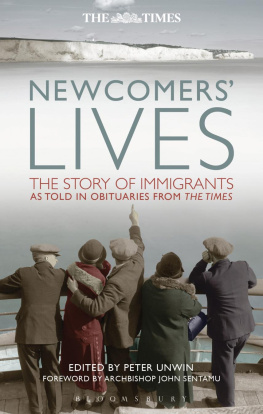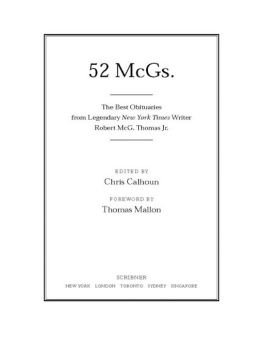THE BEST OF

OBITUARIES 2013
THE SOCIALITE WHO KILLED A NAZI WITH HER BARE HANDS
and 143 Other Fascinating People Who Died This Past Year
AUGUST 2011 TO JULY 2012
Edited and With an Introduction by William McDonald
Foreword by Tom Rachman
WORKMAN PUBLISHING NEW YORK
Contents
Foreword
by Tom Rachman
An obituary is the news column most brimming with life: full of endeavor, blunders, repentance and humor, and the industry of those youll never meet but perhaps wish you had. Each obit records the intersection of a singular personality with an era shared by billions. In some cases, the epoch prevails; in others, the individual. Either way, the account humanizes history, recalling events long forgotten and animating decades that preceded our own.
Nearly unique in news, these are stories with endings. In the international section of a paper, wars conclude, but theres always a reconstruction ahead. In business articles, a bankrupt corporation is landscape in the saga of the economy. In sports, the championship team soon looks to next season.
But an obit is the completed story. After all that striving, this is what there was, flawed or inspirational, with no further outcomes. An ending defines one life, while a multitude of lives begins to define living, sketching out the range of human pursuits, the price of error, the weight of chance, and the disparate uses of time that, in the case of these subjects, ran out over a single year.
There are politicians in this volume, many musicians, a number of poets. Theres an author of experimental fiction that some struggled to read; a writer of lurid novels that fans devoured; a childrens author whose books were roundly praised, intermittently censored and occasionally eaten. There are businessmen with vision enough to popularize the bagel, miniature golf and the Doritos corn chip. One inventor produced millions of couch potatoes with his wireless remote control, while anothers shipping container, his obit states rather astonishingly, is now acknowledged to have been the spark that touched off globalization.
There are Nobel Prize recipients, including one who passed away before hearing the good news. Several award-winning journalists died over the year, two of them while covering the violence in Syria. A third longtime correspondent earned renown for his retorts as much as his reports, savaging foes while enchanting allies with his champagne wit.
Several are profiled for their experiences during World War II, including those who survived the Holocaust and others who battled the Nazis, as well as a man convicted of complicity in the murder of thousands of Jews. A number of the subjects battled for equality during the postwar period, suffering and denouncing injustices based on race, gender and sexuality whose repercussions still roil contemporary society.
Other profiles record final connections to vanished worlds, such as the last veteran of World War I; or a man whose job that of tummler is now so obscure that it requires a definition; and a 111-year-old silent-movie scriptwriter whose obit contains this dynamite opening: She told of Hollywood moguls chasing naked would-be starlets, the women shrieking with laughter.
Those who died young underscore current preoccupations: a conservative blogger, for example, and a tech innovator who named his company after a piece of fruit. There are coincidences, such as the deaths of three iconic TV music presenters; plus two dictators and the daughter of a third, who escaped her cruel father yet never escaped his shadow.
The best way to contemplate what it is to possess a human life is to consider what others have done with theirs.
Some are included for their peculiarity, including an artist preoccupied with U.F.O.s (By his reckoning, 1 in 50 Americans has been abducted by an alien and simply does not know it); an explorer who rowed across both the Atlantic and Pacific oceans; and a gambler who played poker with two presidents, a drug lord and a pornographer though presumably not at the same time.
Most were public figures but some were private, and likely would have remained so had they not been profiled. There is a Coast Guard seaman who, patrolling a foggy Long Island beach in 1942, bumped into a bunch of German saboteurs. Theres the owner of a Brooklyn dive bar who, after all the biographies of deceased laureates and powerbrokers, might seem an ordinary subject. Yet hers is a memorable and touching tale, and a reminder of something familiar from experience but exceedingly hard to convey in news: how full are the lives around us, and how little we know of them.
That defunct lives regain vibrancy in this volume is credit to the superlative New York Times obituarists, who find what is noteworthy in the obscure and what is obscure in the noteworthy. Their accounts are not dry rsums of the eminent; they are what a famed British obituary editor once described as biographical short stories.
Now, some readers may still be uneasy about the obit, touched as it is by the taboo of death. They might be reluctant even to open this book in public, wary of appearing ghoulish, especially if entries provoke a smile, as many should. But there is nothing macabre about this form. The obituary is only occasioned by death; it never dwells on that empty source. Readers ought never shrink from an interest in how others think and behave.
There may, of course, be egoistic motives for reading obits, too. What are the ways in which people die and which might be mine? What are the rewards and risks of living differently than I do? For what might I be remembered?
Such questions cannot be answered. After all, people will never know their own life story. The first years are lost to memory and the last may fade in clarity; or the end arrives abruptly, without the chance for a reckoning. If there is time for review, how accurate can it be, from a perspective that is simultaneously the most privileged and the least objective?
The best way to contemplate what it is to possess a human life is to consider what others have done with theirs. So, we listen to family lore, read literature and turn, with sympathy and curiosity, to the obits.
Introduction
by William McDonald
An obituary in The Guardian happened to catch the eye of a New York Times reporter in London one day, and she sent a Twitter message about it, telling her followers, You have to read this. So I did, and she was right: it was quite a story precisely the kind that I and my colleagues on the New York Times obituary desk hope to come across every day (without wishing anyones demise, of course). Devoted readers do, too, I suspect.
The obituary was about Count Robert de La Rochefoucauld, a dashing man with an elegant name, an illustrious lineage and a rather spectacular past. A descendant of one of Frances oldest families, he was a saboteur in World War II, though that description alone doesnt do him justice. He was also a freedom fighter and an escape artist (not to mention a mayor in a later life), a man of bravery, cunning and ingenuity who had plenty of luck and no compunction about killing. Not surprisingly, The Times commissioned an obit of its own, and it can be read in full further on, but here is an excerpt to suggest why we couldnt resist writing it:
His exploits were legend, involving an eclectic and decidedly resourceful collection of tools in the service of sabotage and escape, including loaves of bread, a stolen limousine, the leg of a table, a bicycle and a nuns habit not to mention the more established accouterments of espionage like parachutes, explosives and a submarine.
Next page







